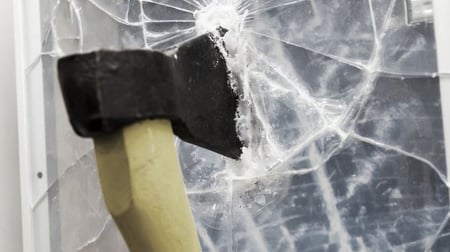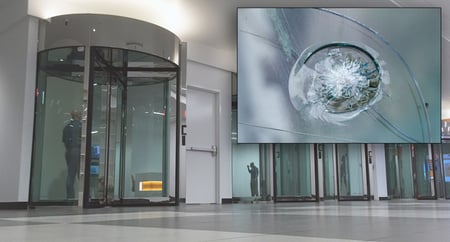Security revolving doors and mantrap portals have never been more popular due to their ability to prevent unauthorized entry without the need for guard services. These doors can be customized in a variety of ways for both aesthetic and security purposes, and glass is no exception, as the material is used to create the door wings or panels and the protective sidewalls.
Let’s walk through the pros and cons of each type of glass available in high security doors and how they can impact your physical security goals.
1. Standard Glass - Not Used in Security Doors
Before we get into the specialty glasses used in security doors, let’s set the stage by first defining “standard” glass. Standard glass is used in windows and interior doors due its light weight, clear visibility and affordable cost. However, this type of glass is not used in security doors due to its lack of strength and breaking pattern. If broken, standard glass will break into various sharp, irregular shapes all over a floor. This can pose a great danger to the public and is therefore not used in commercial buildings.
 2. Laminated Glass
2. Laminated Glass
Laminated glass is a considered a type of “safety glass,” and is comprised of two pieces of standard glass adhered together using plastic as the glue. Because the glass is doubled-up, so to speak, an intruder will find it more difficult to break the glass to gain access through a locked security door. If the laminated glass does break, though, the debris will stick to the interior plastic film rather than falling to the floor in several sharp, jagged pieces. The features that add to the “pros” of laminated glass also contribute to its “cons.” For instance, the thick, stacked nature of the glass makes it heavier than traditional glass and this can make the door wings of a revolving door slower and harder to push (a low energy drive or motor would be helpful here). Also, due to the assembly costs, the price will be higher than traditional glass. In security revolving doors with rotating wings, laminated glass will slow down the speed of rotation and could lower passage throughput. However, for security portals that have sliding doors, the weight is not as big of an issue.

3. Tempered Glass
Tempered glass is considered a “safety glass,” and is created from a single piece of glass that is “tempered” with heat and chemicals for added strength. In fact, GlassDoctor.com says that tempered glass can be up to four times stronger than typical glass of the same size and thickness. Many of us are familiar with tempered glass being used in automobiles for safety reasons. When tempered glass breaks, it will fall to the ground in small, pebble-like pieces with rounded edges that will not easily harm anyone. When it comes to revolving doors and security portals, tempered glass is the least expensive solution and the lightest in weight. For this reason, security revolving doors come standard with tempered glass.
 4. Vandal-Resistant Laminated Glass
4. Vandal-Resistant Laminated Glass
Vandal-resistant glass takes laminated glass to the next level. Instead of laminating standard glass with plastic film, the type of glass used is tempered glass...giving you the best of both worlds. The resulting glass is so strong that it can withstand attempts by a criminal to breach the security door using various tools, such as axes, hammers, crowbars, and electric drills/tools. Vandal-resistant glass will also stand strong against external elements, such as high winds. Due to how it is created, this glass type is more expensive than a laminated or tempered glass alone. The vandal-resistant glass Boon Edam offers is UL 972, which is tested using the "Ball Impact Test" to withstand impact from a 5lb (2.26 kg) steel ball.
 5. Low Iron Glass
5. Low Iron Glass
Low iron glass is a sub-type of glass that can be either tempered or laminated. It is really all about aesthetics. The benefit of this glass type is that it is completely colorless and crystal clear, void of any greenish tints that can be seen in standard float glass. Architects prefer this glass type for new construction and renovation projects where a lot of glass is being used to make a structural statement, or when there are glass storefronts and all-glass revolving doors.
6. Bullet-Resistant Glass
The final glass type available on security revolving doors and mantrap portals is bullet-resistant (BR) glass. BR glass is made of multiple layers of glass and laminate film, and is available in a variety of “levels,” or thicknesses. However, because security doors have moving wings or panels, the glass is available up to Level 3 (29 mm thick). A glass any thicker would be too heavy to allow the door wings to rotate. Level 3 glass can stop three .44 magnum bullets, or a bullet twice as heavy and significantly faster than the bullet of the most common handgun, a 9mm semi-automatic. This glass type is the most expensive option but comes with the strongest benefits.
 If you have any further questions about the glass types available with security revolving doors and mantrap portals, please reach out to our team of Entry Experts who can walk you through the pros and cons of each type based on the goals of your or your client’s building or campus.
If you have any further questions about the glass types available with security revolving doors and mantrap portals, please reach out to our team of Entry Experts who can walk you through the pros and cons of each type based on the goals of your or your client’s building or campus.



